After the success of the Mark 5 Spitfire in Malta, which we looked at in the last Sortie, the Spitfire went on to prove itself again and again in other theatres of war; from the deserts of North Africa, to the jungles of South East Asia, to the frozen tundra of the Russian winter.
Going on to be the most produced Spitfire variant of the war, the Mark 5 was more than a match for any of the Axis Alliance members’ aircraft.
The Spitfire’s continuous development did occur in a vacuum however and the Germans were also developing new aircraft, as well as improving existing models.
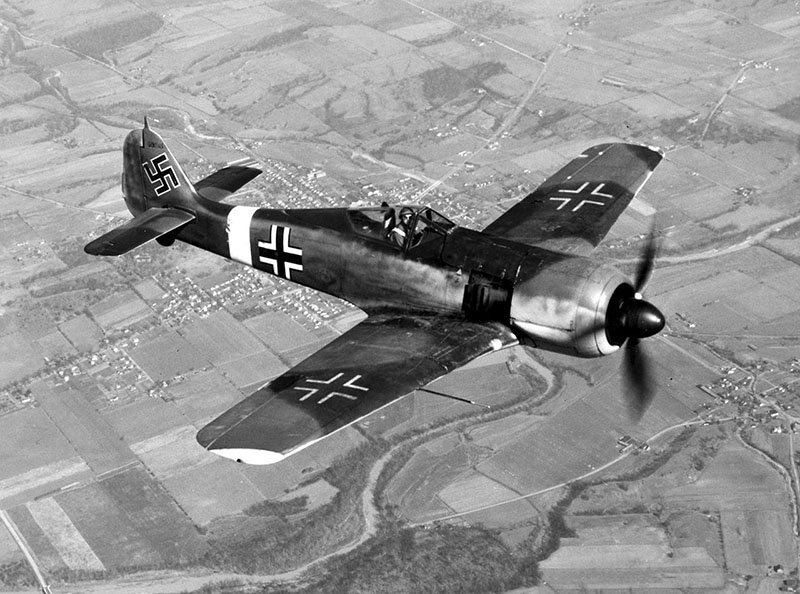
Focke-Wulf Fw190
The Challenger
The Spitfire’s reign supreme would end in August 1941, when the Germans deployed a new aircraft; the Focke-Wulf Fw190. Named Würger (Shrike) by the Luftwaffe, the Allies soon gave it the nickname “Butcherbird”; after a subspecies of shrike who infamously impale their food on thorns.
The Fw190 was fitted with a 42-litre radial engine made by BMW. This gave it the appearance of having a “fat nose” when compared to its slimmer brother, the V12 Daimler Benz powered Messerschmitt Bf109. The BMW 801 engine delivered 1,539hp and pushed the aircraft to 400mph. By October 1941, when the Fw190 had entered serious production, the A2 variant was fitted with four Mauser 20mm cannons and two 7.92mm machine guns.
Such a massive amount of firepower – almost double what the Spitfire Mark 5 could offer – in one of the fastest and most agile aircraft of the war, made for an incredibly deadly combination.
Kurt Tank
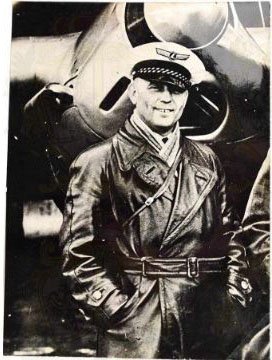
The chief designer at Focke Wulf was Kurt Tank, who also acted as a test pilot for most of his aircraft. When the German Ministry of Aviation issued a competition in 1937, asking for a new single-seat aircraft to compliment the Bf109, Kurt Tank put forward several designs for consideration.
He likened the Bf109 and the Spitfire to racehorses; being both fast and delicate. He also thought that their weapons had been added as an afterthought. Tank wanted his new aircraft to be more akin to a warhorse, robust and heavy hitting. He therefore based his design around the weaponry.
As a veteran of the First World War, he understood that the realities of war meant that aircraft often needed to operate under less-than-ideal conditions and so he put a strong focus on the practical needs of the aircraft. Tank’s background training as an electrical engineer meant that he added redundancies and break points to all the systems, ensuring that each part of the Fw190 failed separately – akin to a fuse board. This made the Fw190 incredibly durable and able to absorb a lot of punishment.
The BMW engine was chosen after Tank had seen the success of American radial engine fighters, such as the Curtiss P-36 Mohawk and the Grumman F4F Wildcat.
The radial engine was also more readily available, as the Daimler Benz V12 engine was already in use by the Bf109 and its bigger brother the Bf110 heavy fighter.
Harmonised Firepower
The Fw190 had two of its cannons mounted next to the fuselage of the aircraft and both the machine guns fitted on top of the engine. As the propeller turned, the guns were synchronised to fire through the gaps – much like the biplanes of World War One.
With the weaponry fitted to the main body of the aircraft, this allowed the Fw190 to hit whatever its nose was pointed at.
The Spitfire meanwhile had guns that were widely spaced along its wings. This was a consequence of having such a sleek and aerodynamic design. This meant that the guns all needed to be harmonised to a set distance; so that the bullets and shells all converged at a set point ahead. This was usually to a point between 200m to 400m in front of the aircraft. Aiming for a target outside of that distance meant that some, or all, of the guns would miss.
The Hurricane had its weapons, although also wing mounted, clustered closer to the fuselage which meant there was less spread than the Spitfire. During the Battle of Britain, this was one of the contributing factors as to why the Hurricanes were able to shoot down more aircraft than the Spitfire.

Although not to scale, this shows the principal behind harmonising guns and the effect of the spread of fire from guns that are placed wider on a wing
Skilled pilots learned and adapted their flying style to compensate for this and the range could be adjusted pre-flight based on what targets were anticipated. Some pilots also chose to personalise their kill zone.
Aggressive pilots, such as the RAF’s Sailor Malan, or Germany’s Erich Hartmann preferred their guns to be harmonised to much shorter distances. For example, Hartmann’s personal Bf109 had its guns set to converge at just 50m; although he preferred to wait until he was at point blank range, just 20m away, before he opened fire. Hartmann is still to this day the world’s top scoring fighter ace, being credited with 352 aircraft shot down.
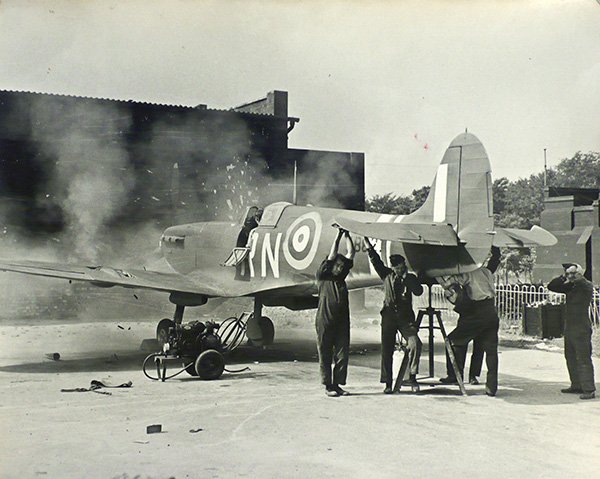
A Spitfire’s guns being harmonised on a firing range. Clearly it was a very noisy business!
The Butcherbird
For the first year after its release, the Fw190 earned its Butcherbird moniker. Helping the Luftwaffe gain air superiority on both the Western and Eastern Fronts. The Fw190 had superior performance to the Spitfire Mk5 in every important area except turning circle – the Spitfire’s most famous characteristic still couldn’t be bettered.
The Fw190 was arguably Germany’s best single seat fighter of the war.
Compared with the Bf109, the Fw190 was easier for novice pilots to fly, much easier to take off and land and could use short or makeshift runways. It also had more armour protection and could carry a larger load of weaponry.
BMW’s 801 engine was air cooled, which made it very durable as there was no fragile radiator that could be damaged. The downside to this was the Fw190 performed less well at higher altitudes, where the air was thinner.
The landing gear in particular had been improved considerably from the Bf109. Over 10% of all Bf109 aircraft, around 3,000 planes, were lost due to accidents during take-off and landing. The Fw190 had a landing gear that could cope with forces three times that experienced during an unpowered landing. This meant a crash-landed aircraft could often be quickly repaired back into flying condition.
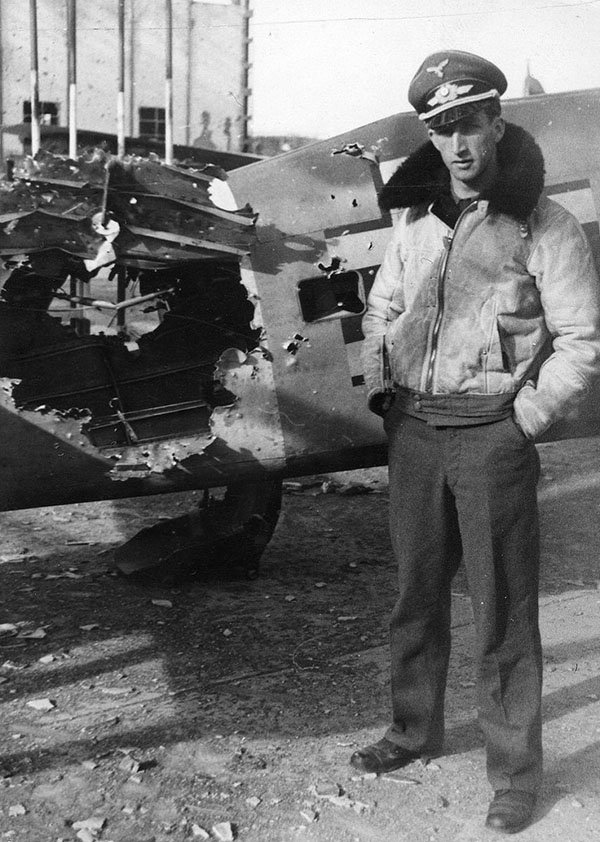
A Luftwaffe pilot posing next to his Fw190. Despite having a direct hit from flak, he had still been able to land
The real strength of the Fw190 however, was that it could cope so well with the Luftwaffe’s deteriorating situation during the second half of the war. Tank’s focus on the Fw190 being a warhorse meant that when faced with severe shortages of parts and trained pilots, along with the need to use improvised airstrips – the Fw190 excelled.
The RAF’s Reply – Spitfire Mark 9
In direct response to this new threat, RAF Fighter Command ordered an upgrade to the Spitfire to be rushed through. Expected to only be a stopgap, in June 1942 the first Mark 9 (IX) Spitfire rolled off the production lines, leap-frogging Marks 6-8. It featured a brand new Rolls-Royce Merlin 61 engine, with a two-stage supercharger, producing 1,560hp.

A flight of Mark 9 Spitfires
The Mark 9 Spitfire proved to be a vast improvement over the Mark 5 Spitfire. The top speed had increased by 40mph to 409mph. The service ceiling had also risen by almost 7,000 feet to 43,000 feet.
This increase in engine power meant the Spitfire could now carry more weaponry without impacting its performance. The Spitfire’s thin elliptical wings had previously led to problems with using the formidable 20mm Hispano cannons; they frequently jammed under the intense vibrations and g-forces experienced during a high-performance dogfight. With the improved “C type” wing, the Spitfire Mark 9 could now be fitted with either two 20mm cannons and two rifle calibre machine guns, or four 20mm cannons in its wings.
Each of the 20mm Hispano cannons fired explosive rounds, each the size of a milk bottle. The rate of fire meant that the cannons would expend all of their ammunition in just 10 seconds. Such destructive force meant that the Spitfire was now deadly against not just enemy fighters, but also heavy fighters and bombers. In its ground attack role, the 20mm rounds would wreck most soft targets such as cars, transport trucks and trains.
Supermarine Spitfire Mark 9 vs Focke-Wulf Fw190
In July 1942, a disorientated Fw190 pilot thought he had safely landed back at his base in France. He had however mistakenly landed at an airfield in Wales. The RAF now had a completely intact brand-new Fw190. They immediately flew it alongside a Spitfire Mark 9 to compare its capabilities. The test pilots found that the flight characteristics of the Fw190 were very similar, with the Spitfire having a slight edge.
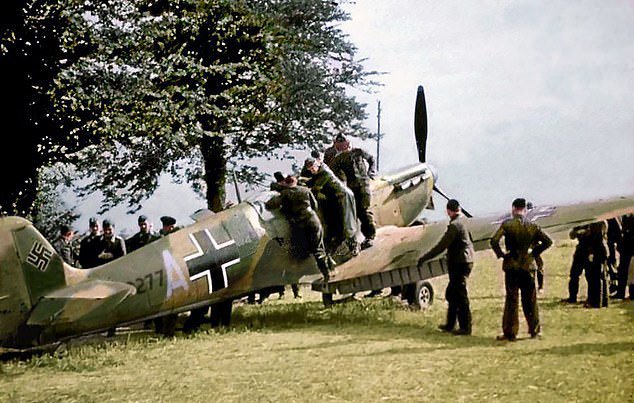
A captured Spitfire, already repainted, being inspected by Luftwaffe pilots
Whenever a Spitfire crash landed on the continent, the Luftwaffe would rush to bring back the wreck, to either repair it to flying condition, or salvage spare parts from it. Due to this they were able to keep their special research unit, Kampfgeschwader 200 (Combat Squadron 200), supplied with a steady stream of salvaged Spitfires. They used these captured aircraft to both train their pilots and practice dogfighting tactics.
When the Luftwaffe recovered a Mark 9 Spitfire, they repaired it and tested it against their Fw190. Their results showed that the two aircraft were also well matched, but concluded that the Fw190 had an overall better performance.
After the war when both these tests could be compared, it was found that the RAF had tested the Spitfire Mk9 vs Fw190 at a high altitude, whereas the Luftwaffe had tested the two aircraft at low altitudes. In effect, the RAF and Luftwaffe were both guilty of testing the aircraft in an environment that favoured their own fighter; skewing the results.
Due to oil supply issues, compounded by the Allied bombing campaign, the Germans were only able to fuel the Fw190 with 95 Octane. Britain, on the other hand, was able to keep its Spitfires fuelled with 100 Octane due to imports from the United States. This gave the Allied fighters a performance boost, which equalled 10-15mph of extra speed; helping in both chasing and escaping from other aircraft.
To compensate for this, later models of the Fw190 were fitted with an emergency fuel boost, which could provide up to an extra 400hp if needed.

A restored Mark 9 Spitfire
Conclusion
The reality was that both aircraft were incredibly capable. Direct comparisons are very difficult to make, as each aircraft had different operational objectives and the context of their use was never balanced.
After D-Day the Fw190 found itself used mostly in a defensive manner, using hit and run tactics. The Spitfire Mark 9 meanwhile was more often employed in an offensive search and destroy role.
In total, roughly the same number of Fw190s were made as Spitfires; around 20,000 aircraft. Production of the Fw190 continued right up until the end of the war in Europe. As the Nazi regime crumbled the Fw190 often found itself flown by poorly trained and inexperienced Luftwaffe pilots, as they made vain attempts to halt the Allied advance.
The Watchmaker – Training and Education
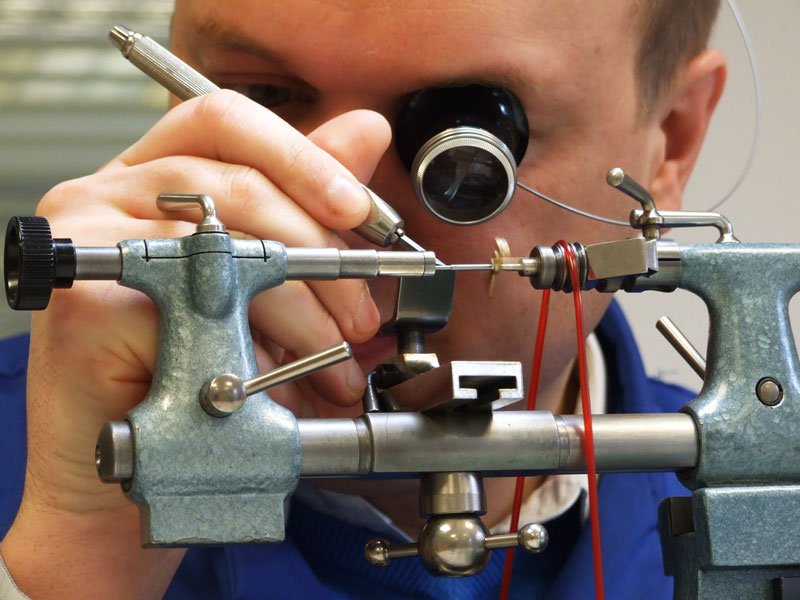
Items like balance staffs and winding stems are made on a lathe. The torque from a motor is too high and so the lathe is instead turned by hand
After a number of Sorties, I thought that I would provide some further details about myself; being the watchmaker who is creating The Few watch. My name is Colin Andrews and I have a keen interest in encouraging people within the watchmaking industry and helping to promote Britain’s pivotal role in watchmaking history; and hopefully being part of its revival.
In this first part, I will explain the training and education process to becoming a watchmaker.
The term watchmaker is often used to describe someone who repairs watches. This is a hold-over from a century ago, when watch repair would often involve the watchmaker crafting parts themselves. Most modern watchmakers however are unable to produce parts by hand, relying instead on replacing worn and damaged parts with new replacements.
When I decided I wanted to be watchmaker, I wanted to learn how to craft parts by hand. That was part of the romantic attraction to the the career; to have the satisfaction of holding something in my hands that I had made myself.
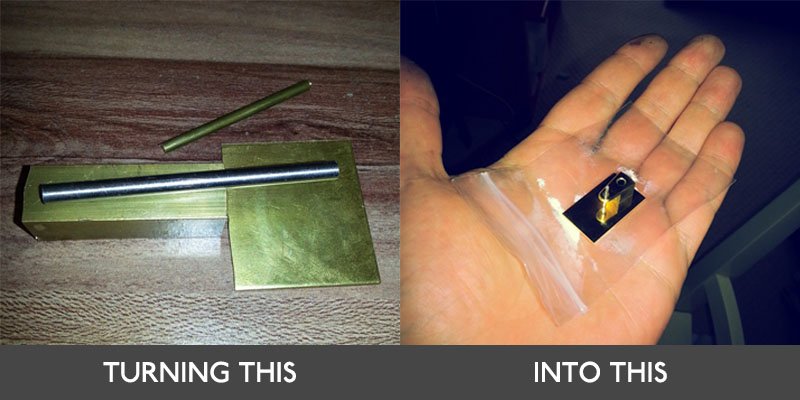
In a watchmaker’s practical exam you are given some pieces of metal and a technical drawing, but no instructions. Over the course of two weeks you need to work out the process to make all the parts, craft them and assemble it all into a working piece
As the modern world doesn’t equip you for working to such a small scale, the only way to learn these skills is through a gruelling training process.
We would practice all day, everyday; sometimes repeating making the same part for months. When you make a mistake; “too bad, now do it again”. When you get it right, “great, now do it again”. Through this relentless training your muscle memory improves and it becomes a more natural task. The concentration required never diminishes though.
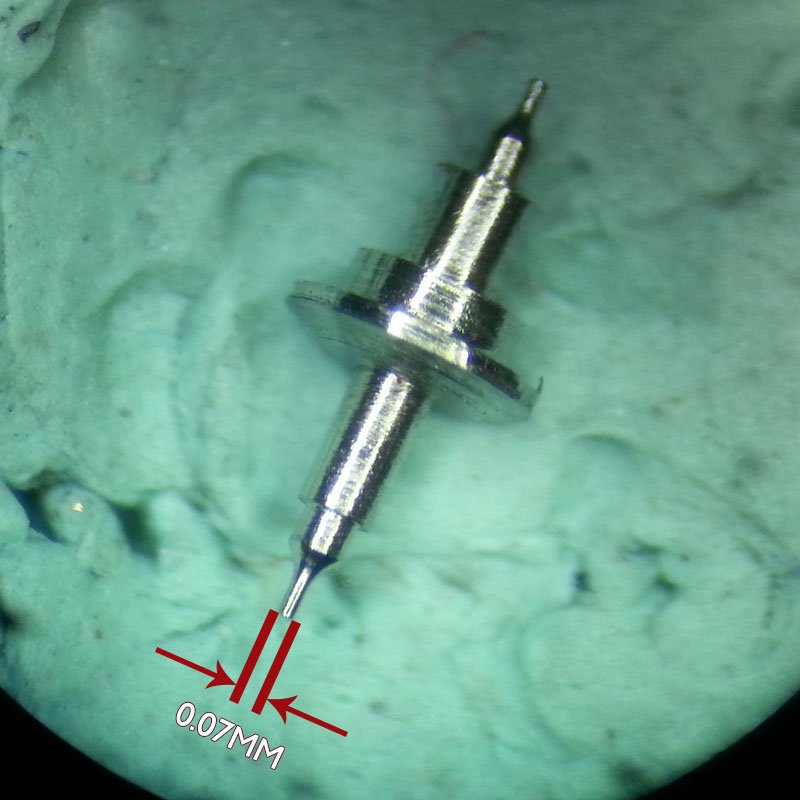
A balance staff I have made. This is perhaps the most difficult part of a watch to make by hand, as the dimensions are so small and the tolerances so tight – just 0.001mm in parts (10 microns). The pivot highlighted is the same thickness as a human hair
Each one takes 4-8 hours to make. If you lose concentration for a split second, you’ll make a mistake and have to start it all again.
I had decided that I wanted to take both the British Horological Institute’s exams and the Swiss WOSTEP exams concurrently. It was double the work, but I knew that it had been done before, albeit decades previously. That would leave me being as qualified as possible and by learning both the Swiss and British methods of working, I could combine the two.
The exams were taken by students worldwide. Facing tough competition, I managed to win 5 prestigious awards. These included the best practical piece (hand-made parts), best technical drawings, as well as the best overall results. The British Horological Institute also made me a Fellow of the Institute.
With the training now completed, it was time to put the skills to use, as well as to help train the next generation of watchmakers. I will talk about this next time.

Collecting my prize for the best overall exam results. The man shaking my hand was at the time the Queen’s clockmaker, who also looked after “Big Ben”
Next Sortie
We will look at the Spitfire before and after D-Day. Pilots who had been safely training in Canada now join the fray in their Mark 9 Spitfires and demonstrate the aircraft’s true prowess.
See you there.
https://www.great-british-watch.co.uk/sortie-11-spitfire-aces/




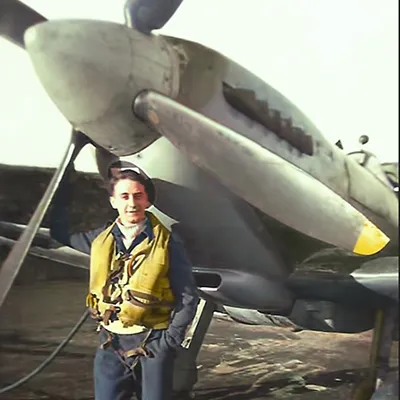

Russ Carter
23 October, 2023 at 8:24 am
Fabulous article. Thank you for sharing.
Makes for great reading.
Colin
4 November, 2023 at 10:53 pm
Thanks Russ, I’m glad you enjoyed it!